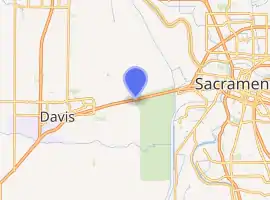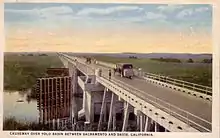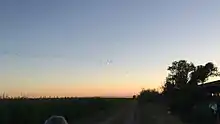Yolo Causeway
The Yolo Causeway is a 3.2-mile (5.1 km) long elevated highway viaduct on Interstate 80 that crosses the Yolo Bypass floodplain, connecting the cities of West Sacramento, California and Davis, California. It is officially named the Blecher-Freeman Memorial Causeway after two California Highway Patrol officers who were killed in the line of duty on the causeway.
Yolo Causeway | |
|---|---|
 Yolo Causeway from the Yolo Bypass Wildlife Area (2014) | |
| Coordinates | 38.563494°N 121.638392°W |
| Carries | 6 lanes of pedestrians and bicycles |
| Crosses | Yolo Bypass |
| Locale | Yolo County, California |
| Official name | Blecher-Freeman Memorial Causeway |
| Maintained by | Caltrans |
| NBI | 22 0044 & 22 0045 |
| Characteristics | |
| Design | prestressed concrete tee beam |
| Total length | 3.2 miles (5.1 km), divided into 877.8-metre (2,880 ft) western segment and 2,682.2-metre (8,800 ft) eastern segment |
| Width | 35.7 metres (117 ft) |
| No. of spans | 72 (western segment) 127 (eastern segment) |
| History | |
| Opened | 1916 (original), 1962 (current) |
| Statistics | |
| Daily traffic | 150,000 (2010) |
| Location | |

| |
History
Ferry service was usually required to cross the Yolo Bypass basin during seasonal flooding; the first county seat of Yolo County was the town of Fremont, built near the ferry crossing near the confluence of the Sacramento and Feather Rivers. Fremont was wiped out during the floods of 1851.[1]:3.6–5 As an alternative, settlers established the Yolo Plankroad, which was a 4.5-mile (7.2 km) long route that ended close to present-day Woodland, California.[1]:3.6–6
Before a causeway was built, wheeled vehicles between Davis and Sacramento were forced to detour south through Tracy and Stockton during seasonal flooding.[2] Once the ground was sufficiently dry to support vehicle traffic, the first vehicle to make it across the Yolo Bypass established the seasonal "Tule Jake" Road, which was typically passable only during the summer months.[3]
1916 causeway

The original Yolo Causeway opened on 18 March 1916[4] as a two-lane structure 21 feet (6.4 m) wide and 16,538 feet (5,041 m) long,[5] connecting what is now the city of West Sacramento with Davis, California.[2] Residents celebrated with the four day-long Causeway Celebration, held from May 11–14, 1916.[1]:3.6–7
Initially, the causeway was composed of a timber trestle section (2,470-foot (750 m) long, on the west) and a concrete trestle section (remaining length), with a 113-foot (34 m) plate girder bascule span, which was opened to permit passage of levee maintenance barges.[5] The causeway width was doubled in 1933 when a new all-timber viaduct was added just south of the 1916 reinforced concrete structure; lights were added in 1950.[2]
The Lincoln Highway association initially declined to shift its route to take advantage of the Yolo Causeway,[6] but in 1928, following the completion of the Carquinez Bridge, it was made a part of the re-routed Lincoln Highway, the first road across America. Later, the causeway became a part of US Highways 40 and 99W.
1962 causeway
The current causeway was built in 1962.[4] From west to east, the causeway is composed of twinned 2,880-foot (880 m) long concrete trestles, a 4,700-foot (1,400 m) long earth fill segment, and twinned 8,800-foot (2,700 m) long concrete trestles. The easternmost of the two bridges is the longer of the two and traffic reporters will sometimes refer to the two structures as the "long bridge" and the "short bridge". Each trestle carries a 46-foot (14 m) wide, three-lane roadway.
It was renamed the "Blecher-Freeman Memorial Causeway" in 1994,[7] after two California Highway Patrol officers who were shot to death in 1978 after a highway stop near the causeway.[8]
| Vicinity of Yolo Causeway & Bypass 1 2 3 4 5 6 |
Proposed improvements
.jpg.webp)
In 2018, Caltrans announced plans to extend the carpool lane along I-80 from Solano County to Sacramento County, which includes plans to widen the causeway to four lanes in each direction. The proposed widening would not start until at least 2024, and the project is estimated to cost $800 million. One proposed alternative would use the extra lane as a toll lane.[9]
Bypass
The 25,500-acre (10,300 ha) Yolo Bypass protects Sacramento and other California Central Valley communities from flooding. During wet seasons, it can be full of water. It contains the Vic Fazio Yolo Wildlife Area, the largest ecological restoration project west of the Everglades. Other nature preserves in it include the Fremont Weir Wildlife Area and Yolo Bypass Wildlife Area.
The Yolo Bypass begins at the Fremont Weir Wildlife Area, located approximately 15 miles (24 km) northwest of Sacramento and lying south of the Sacramento River, upstream from its confluence with the Feather River. When seasonal rains cause the river to rise, water is diverted via the concrete Fremont Weir into the Yolo Bypass floodplain. The Yolo Bypass can carry up to five times the capacity of the Sacramento River, preventing it from flooding Sacramento. The diverted water re-enters the Sacramento River delta near Rio Vista.[10] A 2002 study showed that water begins to flow from the Sacramento into the Fremont Weir when the flow reaches approximately 2,000 cubic metres per second (4,200,000 cu ft/min); for comparison, the capacity of the Yolo Bypass is 14,000 to 15,000 cubic metres per second (30,000,000 to 32,000,000 cu ft/min).[11]

Approximately 250,000 Mexican free-tailed bats migrate to the Yolo Causeway every June. They roost in the expansion joints between the causeway segments, and feed on the insects that live in the wetlands formed by the Yolo Bypass.[12]
Cultural influence
The Causeway Classic is named after the causeway, and refers to the annual college football game between the Aggies of the University of California, Davis and the Hornets of California State University, Sacramento.[13]
See also
 Transport portal
Transport portal Engineering portal
Engineering portal California portal
California portal
References
- EDAW, Inc. (June 2008). "3.6 Cultural Resources". Yolo Bypass Wildlife Area Land Management Plan (Report). California Department of Fish and Game. Retrieved 5 December 2019.
- Meyer, J.G.; Hart, Alan S. (September–October 1961). "Progress on US 40 – Carquinez to Sacramento" (PDF). California Highways and Public Works. California Department of Transportation. 40 (9–10): 6–10. Retrieved 2 August 2015.
- "There's No Way to Get There From Here" (PDF). The Traveler. Lincoln Highway Association – California Chapter. 13 (3). July 2012. Retrieved 2 August 2015.
- Colley, R.F.; Chapman, M. (May–June 1962). "Yolo Causeway: New Crossing Is Scheduled for Early 1963 Completion" (PDF). California Highways and Public Works. California Department of Transportation. 41 (5–6): 44–49. Retrieved 27 July 2015.
- Sutton, W.E. (June 1940). "Redecking the Yolo Causeway" (PDF). California Highways and Public Works. California Department of Transportation. 18 (6): 16, 32. Retrieved 2 August 2015.
- "Causeway Not On Lincoln Highway". The Lodi Sentinel. 17 June 1916.
- "Assembly Concurrent Resolution No. 119". Act No. ACR 119 of 11 April 1994. Retrieved 2 August 2015.
- Faigin, Daniel. "California Highways - Interstate 80". Retrieved 2008-12-02.
- Resnik, Max; Cummings, Brandi (June 6, 2018). "Caltrans ready to expand Yolo Causeway, seeks public's input". KCRA 3 NBC. Retrieved 5 December 2019.
- "Yolo Bypass quietly keeps Sacramento on dry ground". ABC 10 News. December 14, 2016. Retrieved 5 December 2019.
- Schemel, L.E.; Cox, M.H.; Hager, S.W.; Sommer, T.R. (September 2002). Hydrology and chemistry of floodwaters in the Yolo Bypass, Sacramento River system, California, during 2000; Water Resources Investigations Report 02-4202 (PDF) (Report). U.S. Geological Survey. Retrieved 5 December 2019.
- Costabile, Dominick (12 August 2012). "Going batty: Migrants roost under causeway". Davis Enterprise. Retrieved 2 August 2015.
- "Journal: 50 Years – Hooray for Causeway". csus.edu.
| Wikimedia Commons has media related to Yolo Causeway. |
External links
- Yolo Causeway - Davis Wiki
- Caltrans timeline
- CHP Memorial: Blecher-Freeman
- Blow, Ben (1920). "XI. Division III – The building of the Sacramento-Yolo Causeway". California highways: a descriptive record of road development by the state and by such counties as have paved highways. San Francisco: H.S. Crocker Co. pp. 71–75. Retrieved 2 August 2015.
- "The Yolo Basin Concrete Trestle". The Architect and Engineer. 47 (1): 97–100. October 1916. Retrieved 2 August 2015.
- "Yolo 80 Corridor Improvement Project". Caltrans.